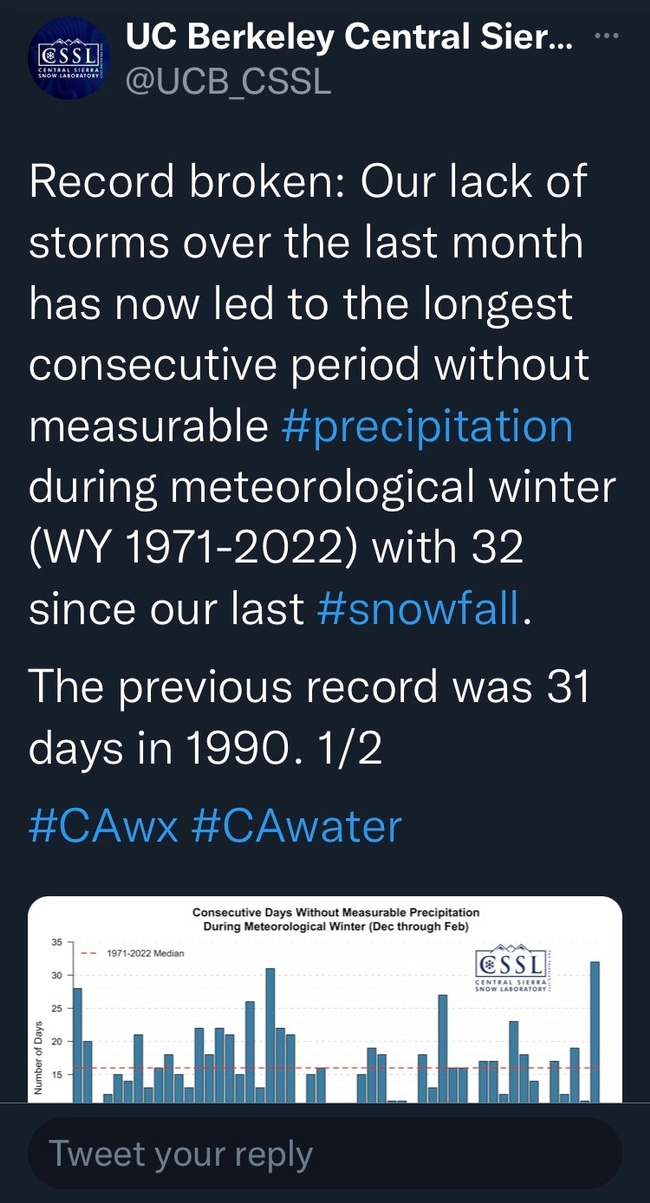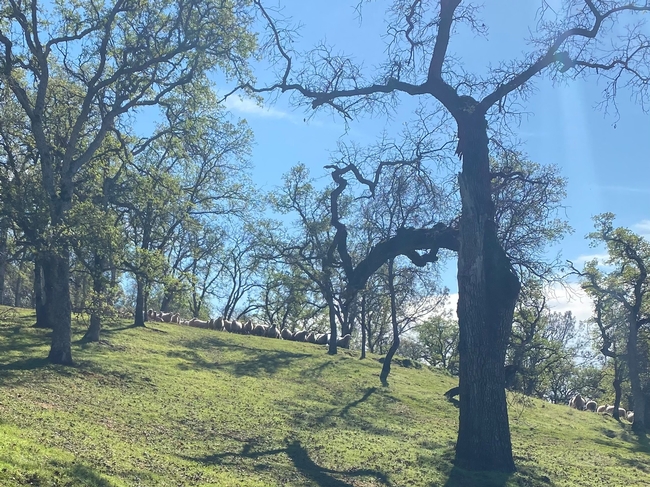I feel like I've said this every year for the last decade, but what a strange weather year we're having! Here in Auburn, we experienced the most intense rainfall in October that I can remember (with more than 8 inches falling in a 48 hour period). November was drier than "normal," but December turned wet and cold. We measured more than 12 inches of precipitation in December at home (including a bit of snow). Just up the hill from us though, record amounts of snow fell - the UC Berkeley Central Sierra Snow Lab on Donner Summit set an all-time record for December with 193.7 inches of snow!
Unfortunately, the Snow Lab set another record yesterday - the longest consecutive period without measurable precipitation during meteorological winter (32 days) since the lab was established in 1971. Today, February 10, marks the 33rd day without rainfall here in Auburn. And our high temperature today is supposed to be over 70F. Despite the promising start we saw in October, we're once again dusting off the drought plan for our small sheep operation.
Every drought, obviously is different - as is every year within a multi-year drought. During the winter of 2013-2014, for example, we went 52 days (from early December through the end of January) without rainfall in Auburn - but we measured more than 14 inches in February and March. In December 2014, we measured over 11 inches - followed by 0.01 inches in January 2014. In the first year of the current drought (2020), we had just 0.03 inches in February, but measured more than 12 inches from March through May. Last year, in contrast, we received just 0.18 inches after April 1.
But rangeland drought is more than simply a lack of precipitation, and rangeland forage production depends on many factors in addition to rainfall. Critically, drought is the interaction of lack of precipitation and soil-moisture deficit driven by high temperatures and increased evapotranspiration. On California's annual rangelands, seasonality of precipitation and climate-soil interactions result different drought impacts depending on the season. While fall drought can obviously lead to winter and spring drought, I found it helpful to think about our own drought plan based on the different impacts we see depending on the time of year.
- Fall Drought: driven by a lack of fall precipitation, fall drought causes a delay in germination on annual rangelands. This can lead to a lack of fall and winter forage (both in terms of quality and quantity), as well as a lack of stock water. Our 2013-2014 drought is a good example.
- Winter Drought: To some extent, California's annual rangelands experience some degree of winter drought most years - the days get too short, and the air and soil temperatures get too cold, to grow much forage. When combined with a lack of precipitation (like in January 2015), this can lead to a lack of both forage and stock water in winter and early spring.
- Spring Drought: This type of drought is driven by a lack of precipitation and warm temperatures in late winter and early spring, leading to increased evapotranspiration and decreased soil moisture. We see perennial plants (including oaks and brush) come out of dormancy early. We may also see our rangeland forage head out early, which results in a decrease in forage quality. Lack of precipitation and dry soils can also result in decreased runoff, impacting stock water availability. Finally, a dry spring (combined with seasonal overstocking of our ranch) can lead to a lack of dry forage next fall. For me, the dry spring of 2021 is a perfect example.
- Summer Drought: While a lack of precipitation is normal in Mediterranean climates like ours, summer drought from a forage perspective is driven by lack of winter snow pack and resulting cuts in irrigation water, or decreases in mountain forage production. With our record low snow pack in 2015, many ranchers didn't receive normal irrigation deliveries. The lack of snow and rapid snow melt last year (2021) meant many high-country grazers in the Sierra had their grazing seasons slashed.
So what does this drought taxonomy mean for our sheep outfit? What kinds of strategies are available to us given the particular conditions in February 2022?
I shared the descriptions above with my colleague Josh Davy (who's the livestock and range advisor for Glenn, Colusa, and Tehama Counties, and who runs his own cattle). He said, "My starting point is to set my stocking rate so that I can survive December and January - those are the toughest months, feed-wise." We've done the same thing - the 2012-2016 drought taught us to be conservative with our stocking rate. Last September, when we turned in the rams, we kept the number of ewes and replacement ewe lambs we felt like we could graze through the winter.
But what about now? We'll start lambing within the next week - which means we've put a year's worth of expense into these ewes to get them to the point where they'll give us something to sell this summer. We're continually looking at the amount of forage ahead of us as we approach our lambing season; we're also looking back to see if the pastures we've already grazed are regrowing. This week's planning meeting was depressing: the forage we've grazed since late December isn't regrowing at all, which means we'll need to rely on what we have left (if it stays dry). And what we have left will only feed the ewes through the third or fourth week of March - we'll be short about 3 weeks (we will move to another ranch in mid-April).
Ultimately, we have two options - we can increase our forage supply (by purchasing hay or grazing difficult-to-access pastures), or we can decrease our forage demand (by selling sheep). As with any plan, there are tradeoffs to both of these approaches - we can increase costs and/or labor, or we can decrease our income. For now, we've settled on the following strategies:
- We'll graze hard-to-fence pastures and move sheep more frequently if necessary up through the first week of lambing. Every extra day we buy now will give us one more day of forage in late March. As the ewes drop more lambs, however, they'll become more difficult to move (which requires more time and effort on our part). Since we typically don't reach peak lamb drop until early March, this gives us a window of about 3 weeks to access these difficult pastures.
- Based on past experience 85-95 percent of our ewes will have lambed by March 31. We may have a few stragglers, but we should be close to finished. If we haven't had an inch of rain by then, and if there's no rain in the 14-day forecast, we'll sort off the ewes that haven't lambed and sell them. Late lambs won't wean as heavy, which means they won't generate as much income. Selling the ewes will reduce our forage demand.
- Based on these strategies, if we get to late March or early April and find we don't have adequate forage for the pairs (ewes and lambs), we'll feed hay until we ship the sheep home for shearing in the third week of April. From that point, we think we'll have enough forage to make it till weaning in late June.
- Finally, if it stays dry through the rest of the growing season, we'll look at further de-stocking to conserve our fall forage. We might sell more ewes, or we might wean the lambs early. We might do both.
These are not easy decisions - ever! But I find that they are easier when we've talked through them and weighed all of our options. And I also find that setting some key dates for implementation helps take the emotion out of the decision - and holds me accountable. Uncertainty, for me, is more unpleasant than making a difficult decision.
